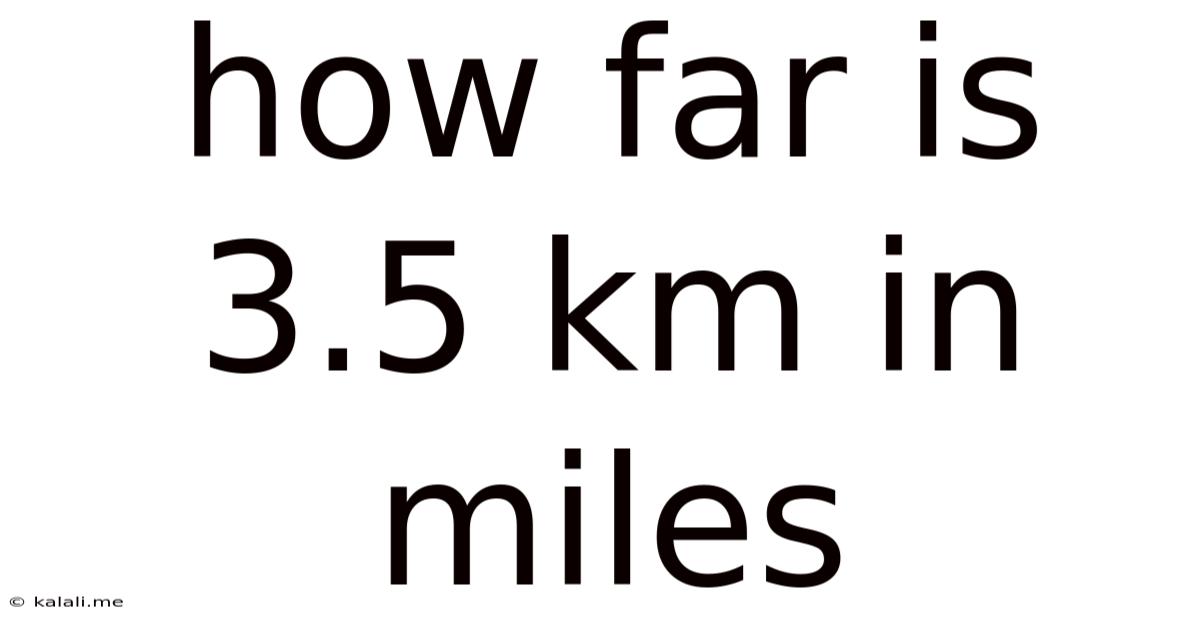How Far Is 3.5 Km In Miles
Kalali
Aug 20, 2025 · 4 min read

Table of Contents
How Far Is 3.5 km in Miles? A Comprehensive Guide to Metric and Imperial Conversions
Knowing how to convert between kilometers and miles is a crucial skill, whether you're planning a road trip, interpreting fitness tracker data, or simply understanding distances mentioned in international news. This article will delve deep into the conversion of 3.5 kilometers to miles, exploring the calculation, the practical implications of this distance, and offering a broader understanding of metric and imperial unit conversions. We'll even touch upon some helpful tools and techniques for future conversions.
Understanding the Conversion Factor: Kilometers to Miles
The fundamental difference between kilometers (km) and miles (mi) lies in their definition. A kilometer is a unit of length in the metric system, equal to 1000 meters. A mile, on the other hand, is a unit of length in the imperial system, historically defined differently across various countries. The most commonly used definition today is the international mile, which is approximately 1609.344 meters.
Therefore, to convert kilometers to miles, we use the conversion factor: 1 kilometer ≈ 0.621371 miles. This means one kilometer is roughly 0.62 miles. The approximation is necessary because the conversion factor is an irrational number, meaning its decimal representation goes on forever without repeating.
Calculating 3.5 km in Miles
To convert 3.5 kilometers to miles, we simply multiply the number of kilometers by the conversion factor:
3.5 km * 0.621371 mi/km ≈ 2.1747985 mi
Therefore, 3.5 kilometers is approximately 2.17 miles. For most practical purposes, rounding to two decimal places (2.17 miles) is sufficient.
Practical Implications of a 3.5 km (2.17 mile) Distance
A distance of 3.5 kilometers, or approximately 2.17 miles, represents a moderately challenging walk or run for an average person. Let's explore some scenarios where this distance might be relevant:
-
Running or Jogging: A 3.5 km run is a common distance for many runners, often used as a training run or a part of a larger training plan. It's a good distance to build endurance and improve cardiovascular fitness.
-
Cycling: 3.5 km on a bicycle is a short to moderate ride, suitable for a quick commute or a leisurely spin around a neighborhood park.
-
Walking: This distance represents a brisk 30-45 minute walk, depending on pace. It's a healthy form of exercise and a good way to explore a local area.
-
Driving: In a car, 3.5 km is a very short distance, likely representing a short commute or a quick trip to a nearby destination.
-
Navigation and Mapping: Understanding this distance is crucial when using GPS or mapping applications. Knowing that 3.5 km is roughly 2.17 miles allows for better interpretation of distances shown on maps and GPS devices.
Beyond 3.5 km: Mastering Kilometers to Miles Conversions
While we've focused on 3.5 km, understanding the process allows you to convert any distance between kilometers and miles. Here's a breakdown of the general process and some tips:
-
Use a calculator: For precise conversions, a calculator is your best friend. Simply multiply the number of kilometers by 0.621371 to get the equivalent in miles.
-
Online converters: Many free online converters are available. These tools provide quick and easy conversions and often handle different units of measurement.
-
Approximate conversions: For quick estimations, you can remember that 1 km is roughly 0.62 miles. Multiplying the number of kilometers by 0.62 will give you a reasonably accurate estimate.
-
Understanding the inverse conversion: To convert miles to kilometers, you use the inverse conversion factor: 1 mile ≈ 1.609344 kilometers. Simply multiply the number of miles by 1.609344 to get the equivalent in kilometers.
Advanced Considerations: Variations in Mile Definitions and Practical Applications
It's important to note that while the international mile is widely accepted, slight variations exist depending on historical context and specific applications. For example, the nautical mile, used in maritime navigation, is defined differently. Understanding these variations is crucial for specific applications requiring precise measurements, such as surveying or navigation.
Incorporating Conversions into Daily Life:
The ability to convert between kilometers and miles is not just an academic exercise; it's a practical skill applicable in numerous situations. Whether you're interpreting distances in fitness apps, planning international travel, or understanding news reports involving distances, this conversion skill provides a better understanding of the world around you.
Conclusion: 3.5 km, 2.17 miles – and Beyond
Understanding the conversion between 3.5 kilometers and 2.17 miles is just the beginning. Mastering this conversion opens up a world of possibilities, allowing you to effortlessly navigate between metric and imperial units of measurement. By understanding the conversion factor and utilizing available tools, you can confidently tackle any distance conversion, enhancing your understanding of the world and making everyday tasks more manageable. Remember to utilize the various methods discussed above, including calculators, online tools, and approximation techniques, to ensure accuracy and efficiency in your conversions. This newfound skill will undoubtedly prove beneficial in various aspects of your daily life, from fitness tracking to international travel planning.
Latest Posts
Latest Posts
-
What Season Does Ty And Amy Get Married
Aug 20, 2025
-
Why Did The Cow Want A Divorce Answer Key
Aug 20, 2025
-
How To Create Void On Doodle God
Aug 20, 2025
-
What Is 20 Percent Of 250 000
Aug 20, 2025
-
What Color Does White And Blue Make
Aug 20, 2025
Related Post
Thank you for visiting our website which covers about How Far Is 3.5 Km In Miles . We hope the information provided has been useful to you. Feel free to contact us if you have any questions or need further assistance. See you next time and don't miss to bookmark.